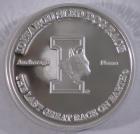2004 Iditarod Medallion

 width= />
width= />
$135.00
The Official Medallion of the 2004 Iditarod Sled Dog Race (known as "The Last Great Race on Earth") had a limited mintage of 3,500 pieces. The obverse design changes yearly while the reverse always features the official logo of the Iditarod Trail Committee. Many of these medallions are sold to Alaskans at race time, which begins the first week of March.
Ed Iten of Kotzebue, Alaska was the winner of the 2003 Iditarod. His biography as provided to the Iditarod Race Committee: Ed Iten, 50, was born in Alaska. He left Alaska and then returned to finish college at UAF where he majored in Biology and Art. For the last 20 years, he’s been a kennel owner and carpenter in the Kotzebue area. He began mushing in the late 70’s. Ed and his wife, Ruth, have two children, Kate, 12 and Quinn, 10. He says he enjoys outdoors, trail making, reloading and trapping.
Seventy to eighty mushers usually take part in the Last Great Race on Earth - the Iditarod, starting in Anchorage the first week of March. They mush along the Iditarod National Historic Trail 1,049 miles to Nome. The race distance is actually somewhere between 1,000 and 1,115 miles – give or take depending whether the northern or southern route is used (the Iditarod Committee decided to use 1,049 – 49 representing Alaska the 49th State). Along the route mushers must make stops at 20 checkpoints, each staffed and supplied by volunteers. With an annual budget of more than 2 million dollars, the Iditarod Trail Committee relies on donations, gift sales (including your medallion!) and fundraisers. One big fundraiser is an auction in which the winning bidders get to take part in the start of the race, riding in the dogsled they bid on, down several miles of 4th Avenue in Anchorage. Prize money goes to each musher who finishes – from more than $50,000 to the winner to $1,049 to everyone who finishes above 20th.
Silver Trivia:
The photographic process is based on the presence of silver halide crystals suspended on an unexposed film, which, when exposed to light, are set in such a way that they are selectively reducible to metallic silver by agents called developers. Approximately 5,000 color photographs can be taken using one ounce of silver.
Although a wide variety of other technology is available, silver-based photography will retain its pre-eminence due to its superior definition and low cost. From its very outset, silver halide has been the material that records what is to be seen in the photograph. As little as 4 photons of light activate silver halides, which amplify that incident light by a factor of one billion times. In today's photography, silver halides are coupled with dyes that bring the color of the world around us into permanent record. An estimated 205 million troy ounces of silver were used worldwide in 2002 for photographic purpose.
